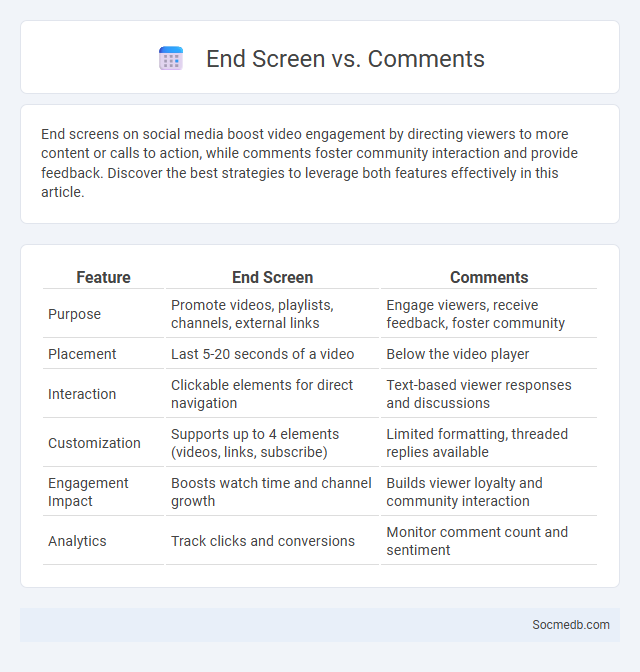
Photo illustration: End screen vs Comments
End screens on social media boost video engagement by directing viewers to more content or calls to action, while comments foster community interaction and provide feedback. Discover the best strategies to leverage both features effectively in this article.
Table of Comparison
| Feature | End Screen | Comments |
|---|---|---|
| Purpose | Promote videos, playlists, channels, external links | Engage viewers, receive feedback, foster community |
| Placement | Last 5-20 seconds of a video | Below the video player |
| Interaction | Clickable elements for direct navigation | Text-based viewer responses and discussions |
| Customization | Supports up to 4 elements (videos, links, subscribe) | Limited formatting, threaded replies available |
| Engagement Impact | Boosts watch time and channel growth | Builds viewer loyalty and community interaction |
| Analytics | Track clicks and conversions | Monitor comment count and sentiment |
Understanding YouTube End Screens
YouTube End Screens play a crucial role in boosting viewer engagement by directing your audience to additional videos, playlists, or external websites within the last 5 to 20 seconds of your video. Leveraging End Screens effectively can increase watch time, subscriber count, and promote cross-channel interaction, ultimately enhancing your content's visibility on the platform. Optimizing placements for clickable elements and tailoring them to your target audience's interests maximizes the impact of these interactive features.
The Role of Comments in Viewer Engagement
Comments on social media significantly enhance viewer engagement by fostering interactive communication and building a sense of community around content. Your active participation in commenting encourages dialogue, increases visibility through algorithmic prioritization, and strengthens the relationship between creators and audiences. These interactions contribute to higher retention rates and drive organic growth by amplifying content reach across platforms.
End Screens: Benefits and Drawbacks
End screens on social media platforms enhance user engagement by directing viewers to additional content, boosting watch time and subscriber growth. They provide measurable insights into viewer behavior, enabling more targeted marketing strategies and increased conversion rates. However, overuse or poor design of end screens can lead to viewer frustration, resulting in decreased retention and negative brand perception.
Comments: Advantages and Challenges
Comments on social media enable real-time interaction, fostering community engagement and user-generated content essential for brand visibility and customer feedback analysis. They drive organic discussions that enhance algorithmic reach, but also present challenges such as moderating inappropriate content, managing spam, and mitigating misinformation. Effective comment management tools and clear guidelines are critical to maximizing benefits while minimizing risks associated with negative user behavior.
End Screen vs Comments: Key Differences
End screens on social media videos serve as interactive elements designed to boost viewer engagement by directing audiences to subscribe, watch more videos, or visit external links, while comments enable direct communication and feedback between creators and viewers. End screens are typically customizable visual call-to-actions that appear during the final moments of a video, enhancing retention and channel growth, whereas comments foster community building and allow for real-time responses and discussions. Measuring performance through analytics, end screens primarily impact click-through rates and watch time, whereas comments influence audience sentiment and provide qualitative insights into viewer preferences.
Impact on Watch Time: End Screen vs Comments
End screens significantly boost watch time by directing viewers to additional videos, increasing session duration by up to 20%. Comments foster community engagement, encouraging viewers to spend more time interacting with the content but have a less direct effect on watch time compared to end screens. Analytics show channels using end screens experience higher viewer retention rates, while active comment sections enhance audience loyalty and repeat views.
Driving Subscriptions: Which Works Better?
Driving subscriptions through social media hinges on strategic content targeting and platform choice, with Instagram and TikTok exhibiting higher conversion rates due to their visual engagement and younger demographics. Personalized ads and influencer partnerships significantly boost subscription rates by fostering trust and relatability. Data shows that subscription campaigns on Instagram yield a 20% higher ROI compared to Facebook, highlighting the importance of platform demographics in subscription growth strategies.
SEO and Discoverability: End Screens vs Comments
End screens on social media platforms significantly enhance SEO and discoverability by providing direct calls-to-action that encourage viewers to engage with additional content, boosting session duration and signaling relevance to algorithms. Unlike comments, which rely on user-generated engagement and can be more variable, end screens offer consistent, strategically placed links that improve content navigation and increase the likelihood of higher rankings in search results. Optimizing end screens with targeted keywords and clear visual cues maximizes their effectiveness in driving traffic and improving overall social media visibility.
Boosting Community Interaction: End Screen or Comments?
Boosting community interaction on social media can be significantly influenced by the strategic use of end screens and comments. End screens encourage viewers to engage by directing them to other content or prompts, while comments foster direct conversations and build a sense of belonging among your audience. Choosing between end screens or comments depends on your goal, but integrating both maximizes your community's active participation and connection with your brand.
Optimizing Your Strategy: End Screen, Comments, or Both?
Maximizing engagement on social media involves strategically using end screens and comments to retain audience attention and encourage interaction. End screens provide clear, actionable prompts to guide viewers towards further content or subscriptions, while active comment management fosters community building and real-time feedback. Combining both tactics enhances content visibility and strengthens audience connection, ultimately driving higher growth and retention rates.
 socmedb.com
socmedb.com